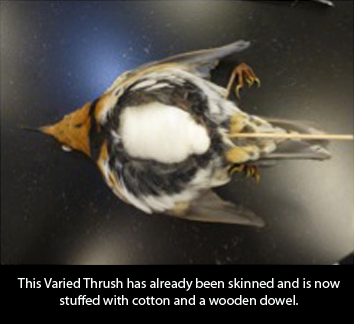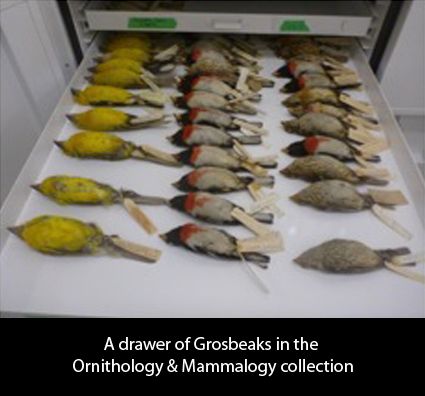
How many of you have walked by the Project Lab and noticed some pretty strange things, and maybe even gross things, happening inside? There’s a good chance that you’ve seen a staff member or volunteer from the Ornithology and Mammalogy department preparing dead birds and mammals for our research collection. The majority of what we do in here is preparing study skins, our main method of preserving specimens.
Study skins are just what their name implies – skins that are studied by researchers. In order to keep just the skin of a bird or mammal, we have to remove any soft parts from the inside that could rot over time. I start by making an incision down the front of the specimen, and slowly separate the muscle from the skin. I’ll continue this process until the whole body is separate from the skin of the animal, severing at the limbs and tail as I go along. This is generally the part that gets the best round of Eeewwwwws from the visitors watching outside the lab. You can see in the picture above that I already have all of the muscle and the body removed from this hawk, circled in blue. It looks just the same as when you get a chicken or turkey at the grocery store!

I now have just the skin of the bird with its feathers attached. In birds we leave a few bones in the wings, legs, feet, and the skull to give the skin some structure. In mammals, there are typically only a few toe bones left inside. Now I can stuff the skin with some cotton and a wooden dowel, shown in this picture of a Varied Thrush. The cotton serves as a body to replace the one I removed, while the dowel helps give additional structure. Once the specimen is stuffed, I’ll sew up the incision. 
 Each animal is then pinned onto a board. We pin them in a specific position so that, when the specimen is dry, it will forever be in this shape. This part is a bit different from traditional taxidermy, where animals are positioned into life-like poses. Researchers don’t need specimens to look life-like in order to take any measurements or samples that they might need, plus it would take up too much space! That’s what study skins are designed to do: create a compact library for researchers to reference. The next time you walk by the Project Lab and see one of us preparing a study skin, stop and watch! It may seem a little gross, but it’s a cool process that’s been around for over 100 years and is essential for us to continue building our library of life here at the Academy.
Each animal is then pinned onto a board. We pin them in a specific position so that, when the specimen is dry, it will forever be in this shape. This part is a bit different from traditional taxidermy, where animals are positioned into life-like poses. Researchers don’t need specimens to look life-like in order to take any measurements or samples that they might need, plus it would take up too much space! That’s what study skins are designed to do: create a compact library for researchers to reference. The next time you walk by the Project Lab and see one of us preparing a study skin, stop and watch! It may seem a little gross, but it’s a cool process that’s been around for over 100 years and is essential for us to continue building our library of life here at the Academy.
Laura Wilson
Curatorial Assistant & Specimen Preparator
Department of Ornithology and Mammalogy